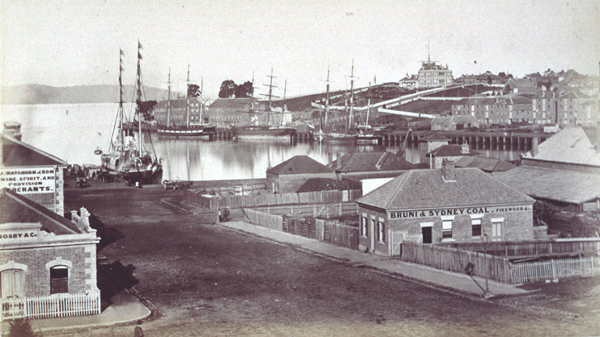 |
 |
|
Battery Point
Battery Point is that landform along the southern shore of Sullivan's Cove. It was the site of the first battery of guns established by Lt-Governor Collins, and the first residence outside the 'camp' which comprised the early settlement: Cottage Green, built by the Rev Robert Knopwood in 1805 on a grant of 30 acres. This grant and another 90 acres to William Sorell covered almost the entire area of Battery Point, with the Signal Station and Guard House (1818), and Barracks Hill, chosen in 1811 as the site for Anglesea Barracks. In 1824 Sorell's land passed to William Kermode, but a proposal to divide Knopwood's land caused an inquiry, which resulted in John Lee Archer's proposals becoming the Sullivans Cove/Salamanca development as we know it today. Arthur's insistence on a foreshore road and wharf apron saw Salamanca Place extended to include the 'new wharf' area – a boon to the future of the working port, albeit a reclamation project that took thirty years of convict labour to complete. The release of the Sorell/Knopwood land saw the erection of a series of villas along the escarpment that became Hampden Road, notably Heathfield, Narryna, Stowell, Rosebank, Lenna and Secheron. These fine homes were overshadowed by two prominent structures, Luckman's windmill (1836, demolished 1885), and St George's Church (1836), which still stands proudly on its eminence, its inspiring tower, designed by James Blackburn, an attractive landmark for all of Hobart Town, a welcome sight for many generations of mariners. Battery Point also became the home of generations of ship owners, builders, masters and crew and wharf labourers and their families, and so a mix of poverty and wealth. In the 1960s and 1970s it was the site of battles between developers and lovers of Hobart's heritage, which after a bitter struggle the latter won. With its restored cottages, splendid homes, shipyards and the drawcard of Arthur's Circus, Battery Point is now a major tourist attraction. Further reading: A Rowntree, Battery Point today and yesterday, Hobart, 1951. Des Hanlon |
Copyright 2006, Centre for Tasmanian Historical Studies |
